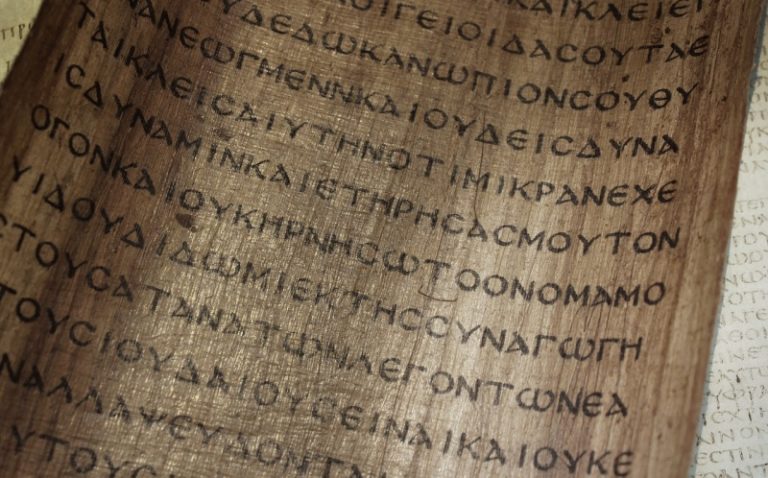In the quest to answer my original question, “How do you know the Bible is true?” the validity of the historical accounts of the life and resurrection of Christ provided particularly compelling evidence. I’m not talking about the theological concept of the resurrection, that’s a different topic. In this regard, I’m speaking of the data that supports the validity of the historical accounts of Jesus.
So, what is the evidence for the historical reliability of the New Testament? In order to answer this question, it is important to identify the necessary criteria for evaluating the validity of a historical account. Some points to consider include (1) the author, (2) the author’s credibility, (3) presence of eye-witness testimony, and (4) the time distance between the event itself and the written record.
For the purpose of establishing references, first the data for source material on Alexander the Great (d. 323 BC) is considered by Gary Habermas.[1] There remain no contemporary historical accounts of Alexander; only six later sources are available.[2] Of these later sources, three are deemed “not credible” because the authors reveal nothing about themselves, their sources, nor the critical methods they utilized.[3]
Plutarch, credible source #1, cited many authors; but specifically stated he was not writing a history. Arrian, credible source #2, relied heavily on two primary sources, Ptolemy and Aristobulus (these two do not remain today). Arrian accepted these accounts without question, however they were fraught with vast discrepencies. When faced with these disagreements, Arrian simply chose that which he preferred.[4] These two historians, Plutarch and Arrian, wrote their accounts 300-450 years after the death of Alexander the Great. These types of sources provide the historical account of Alexander accepted by scholars today.
Another historical example to consider is Tiberius Caesar (d. 37 AD), a contemporary of Jesus and man of great importance. For Tiberius, there are 10 credible historical sources, 4 of which are classified as major sources. Of the 4 major sources, 1 is contemporary to Tiberius, but it is the least useful. Tacitus, the best source, was written in 120 AD, 80 years after the death of Tiberius. Dio Cassius, another excellent source, was written 180 years after Tiberius’ death.[5] These two sources also have discrepancies between them, yet they are accepted by historical scholars.[6]
According to Habermas, there are about a dozen and a half non-biblical sources for Jesus that are dated within 100 to 150 years of Jesus.[7] The biblical sources are even earlier. The date of the crucifixion is considered to be either 30 or 33 AD. For this analysis, the widely accepted date of 30 AD will be utilized as it is the earliest. Here is a brief time line of the biblical record data.
| Event or Document | Date Authored |
Time Distance |
Eyewitness Account In Document |
| Christ’s Crucifixion | 30 A.D. | + 0 years |
|
| Paul’s Conversion | 32-33 A.D. | + 2-3 years |
|
| Paul in Jerusalem Peter & James (brother of Jesus) 15 days |
35-36 A.D. |
+ 5-6 years |
Agreement in gospel accounts between Paul, Peter, & James |
| Paul, Barnabas & Titus in Jerusalem Peter, John, & James |
48 A.D. | + 18 years |
Agreement in gospel accounts between Paul, Peter, John & James |
| Paul visits Corinth |
51-52 AD | +21-22 years |
Archeological inscription confirmation |
| 1 Corinthians | 55 A.D. | + 25 years |
Yes |
| Galatians | 57 A.D. | + 27 years |
Yes |
| Mark | 70 A.D. | + 40 years |
Yes |
| Matthew | 80 A.D. | + 50 years |
Yes |
| Luke | 85 A.D. | + 55 years |
Yes |
| Acts | 90 A.D. | + 60 years |
Yes |
| John | 95 A.D. | + 65 years |
Yes |
Even if only Paul’s account is considered, Paul passes the credibly test in that he provides source information regarding himself, those to whom he spoke, locations, and the methods he utilized. Paul was an educated Pharisee in Hebrew tradition & law having studied under Gamaliel. He was also a Roman citizen, well educated in Hellenistic culture, literature and philosophy. Furthermore, he was a zealous persecutor of the followers of Jesus until his conversion on the road to Damascus. Logically, there is no reason to disbelieve Paul as it was far more dangerous for Paul to proclaim the gospel than to not. Historical scholars, both Christian and atheist, accept (1) the account of Paul and (2) that Jesus appeared to multiple witnesses after his death.[8] It is how Christ appeared that is disputed.
Furthermore, the discovery of the Dead Sea Scrolls (DSS) in 1948, the John Rylands MS (aka P52) in 1920 and others demonstrate the integrity of the accounts that remain today. The DSS date to the time of Christ and P52 dates to 130 AD. P52, found in the Nile region of Egypt, demonstrates that Christians were in Egypt with circulating copies of John’s Gospel as early as 130 AD. This certainly supports the original date of John’s Gospel as 95 AD as well as the original content and current integrity.[9]
The purpose of this blog entry is to demonstrate that compared to other accepted historical records, the biblical record is extremely valid. The sources are close to the actual event, contain eye-witness testimony and credible authorship. Even if one only considers the writings of Paul, the evidence for the validity of the historical record regarding Jesus and the resurrection is compelling. One simply cannot disregard the historical validity of the New Testament unless one excludes that of Alexander, Tiberius and many other historical figures. To do so would be illogical and dishonest.
[1] Gary Habermas, “The Resurrection Evidence that Changed Current Scholarship,” To Everyone an Answer: 10thAnnual EPS Apologetics Conference, Panel Presentation. Biola University, September 14, 2013, accessed April 19, 2019, https://www.youtube.com/watch?v=5znVUFHqO4Q.
[2] Lionel Pearson, “The Diary and the Letters of Alexander the Great,” Historia: Zeitschrift für Alte Geschichte 3, no. 4 (1955): 429.
[3] Ibid.
[4] Ibid., 430.
[5] Habermas, Apologetics Conference.
[6] A. J. Woodman, “Tiberius and the Taste of Power: The Year 33 in Tacitus,” The Classical Quarterly 56, no. 1 (May 2006): 176.
[7] Habermas, Apologetics Conference.
[8] Ibid.
[9] https://www.josh.org/8-manuscripts-validate-new-testament/.

